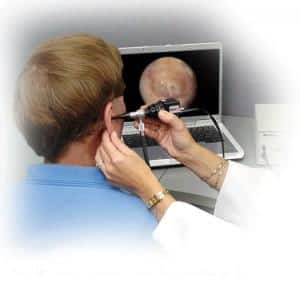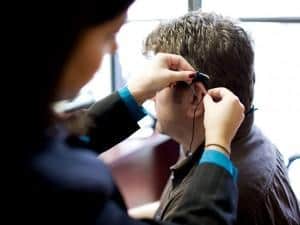Latest posts by Susan L Fenrich, BC-HIS* (see all)
- Pesticides Affect Hearing in Farmers - September 2, 2024
- Hearing Loss is #1 Disability for Veterans - August 1, 2024
- Untreated Hearing Loss linked to Dementia - July 1, 2024
For your protection, both federal and state laws have been set regarding the required procedures in a hearing evaluation performed prior to purchasing a hearing aid. If these procedures are not followed, the hearing health care provider is putting his or her license at risk.
-
-
- A health history form is filled out, including HIPPA compliance forms.
- Ear Examination. Our Specialist uses a video-otoscope to examine the ear canals. The patient gets to see what the
specialist is seeing on a TV or monitor. The ear canal is examined to see if there is a cerumen (wax) impaction, infections, deformities, perforations in the tympanic membrane (ear drum), or any other conditions that might indicate that a medical referral is in order.
- A standard hearing test consists of several steps:
- Bone Conduction Pure Tone Test: Listening to pure tones through the use of a vibrating device that is placed behind the ear on the mastoid bone. This bypasses the mechanics of the ear, sending sounds via vibration to the middle ear.
- MCL= Most Comfortable Level: Speech is used to determine what level is the most comfortable to listen to.
- UCL= Uncomfortable Level: Speech is used to determine the maximum loudness one can tolerate. This is used as a guide to determine the maximum output level of a hearing aid. An unusually low UCL may indicate a medical condition is affecting one’s hearing.
- Speech Discrimination Test: This test involves the repetition of one syllable words. This helps us give realistic expectations as to how well one will understand speech with hearing aids.
- Speech Reception Threshold: The repetition of phonetically balanced two syllable words while decreasing the volume. This determines the minimum hearing level at which one can understand half of the time.
- Red Flags have been established by the FDA to help determine whether a physicians referral is in order:
- Visible congenital or traumatic deformity of the ear.
- History of active drainage from the ear in the previous 90 days.
- History of sudden or rapidly progressive hearing loss within the previous 90 days.
- Acute or chronic dizziness
- Unilateral hearing loss of sudden or recent onset within the previous 90 days
- Audiometric air-bone gap equal to or greater than 15 decibels at 500 Hz, 1,000 Hz, and 2,000 Hz.
- Visible evidence of significant cerumen (ear wax) accumulation or a foreign body in the ear canal
- Pain or discomfort in the ear.
- The patient is required to sign a Federal Waiver of Medical Examination form should they not want to see a physician prior to purchasing a hearing instrument.
- The test results are explained and recommendations are made.
- Together both the patient and the hearing aid specialist will decide which hearing aid will best suit the patients hearing needs based on hearing loss, lifestyle, physical limitation of the ear, cosmetic needs, dexterity, and budget.
- Any necessary impressions are taken and the ear may be measured for proper fit.
- A Detailed Sales Contract is signed.
- Hearing Aids are either fit on that same day or they are ordered.
- Every patient is allowed a minimum 30 day return period.
-
If you have not made an appointment for your FREE Hearing Test, request a hearing appointmenttime right now!
The content contributions of Welsch Hearing Aid Company should not be considered by anyone as a substitute for medical or other hearing health professional diagnosis, treatment, advice, or recommendations.

 specialist is seeing on a TV or monitor. The ear canal is examined to see if there is a cerumen (wax) impaction, infections, deformities, perforations in the tympanic membrane (ear drum), or any other conditions that might indicate that a medical referral is in order.
specialist is seeing on a TV or monitor. The ear canal is examined to see if there is a cerumen (wax) impaction, infections, deformities, perforations in the tympanic membrane (ear drum), or any other conditions that might indicate that a medical referral is in order.
